Planning your trip to Rome and not sure what to see in the Jewish Ghetto? You’re in the right place! In this guide, we cover the area’s must-see attractions and hidden gems. Since no cultural exploration would be complete without stopping for something to eat or drink, we’ve also included our top restaurant picks. Enjoy the historic Jewish Ghetto of Rome!
Pro Tip: Planning your trip to Rome? Bookmark this post in a “Rome” folder in your browser so you can easily circle back to it when you’re traveling. Also, check out our dedicated guide to Rome full of resources to help you plan a memorable trip and our top-rated Rome tours.
The Ultimate Guide To the Jewish Ghetto of Rome
Today, the Jewish Ghetto of Rome is not your typical ghetto. It is, in fact, one of the Eternal City’s most desirable neighborhoods and it has a lot of history, plenty of attractions and hidden gems to discover, and some great places to eat.
In this ultimate guide, you’ll find information on the historical context, where to find the Jewish Ghetto in Rome, what to see and do while you’re there, and great places to eat and drink.
- The Origins of the Jewish Ghetto
- Where Is the Jewish Ghetto
- What To See in the Jewish Ghetto
- Where To Eat and Drink in the Jewish Ghetto
The Origins of Rome’s Jewish Ghetto
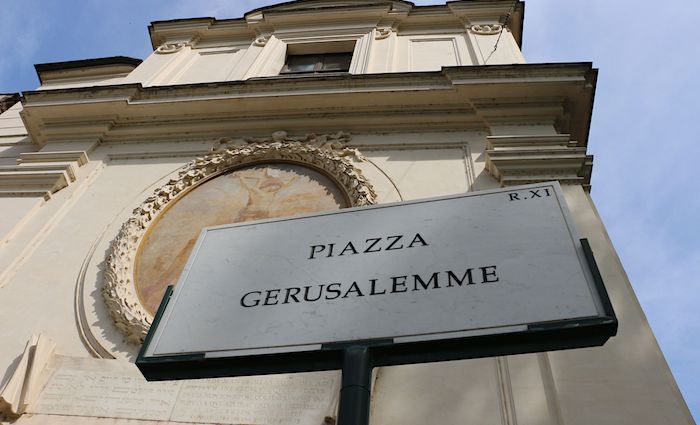
Word Origin
When we hear the word “ghetto”, the majority of us picture a squalid, run-down place that few of us would want to visit on vacation. This was true of Rome’s Jewish Ghetto for over 300 years—yes, three centuries! What does the word “ghetto” mean to you? The word could derive from two possible meanings:
- Borghetto – meaning small borough.
- Getto – meaning foundry or factory.
The second, although spelled differently, is most likely the origin, because the first Jewish Ghetto was created on the site of a foundry in Venice in 1516. For almost 500 years, the conditions of the Rome and Venice Jewish Ghettos were horrendous.
They were often flooded and the living conditions were appalling, inhumane by today’s standards. Now, it’s a very different story and real estate values in these areas have shot through the roof.
Brief History
It all started back in 1555 when Pope Paul IV declared that the Jews in Rome would be restricted to one area of the city and the location he chose was not by accident. As you can imagine, it wasn’t a pretty area. Close to the Tiber river, it was constantly flooding, which created very unhygienic conditions.
To further alienate the Jewish community, a wall was erected around the area where they were to live. The rules varied throughout the centuries, but the general rule was that for most of their lives, Jews were confined to this small area. If they left, they would have to pay a fee. The neighboring Mattei family were in charge of collecting this fee and profited handsomely from their misery. In 1870 the Jews were finally liberated from the confines of the so-called ghetto after being confined to this small area for over 300 years.
Within the next decades after 1870, the whole area called the Jewish Ghetto was demolished and rebuilt over the river level.
Museo Ebraico di Rome
Where Is the Jewish Ghetto of Rome?
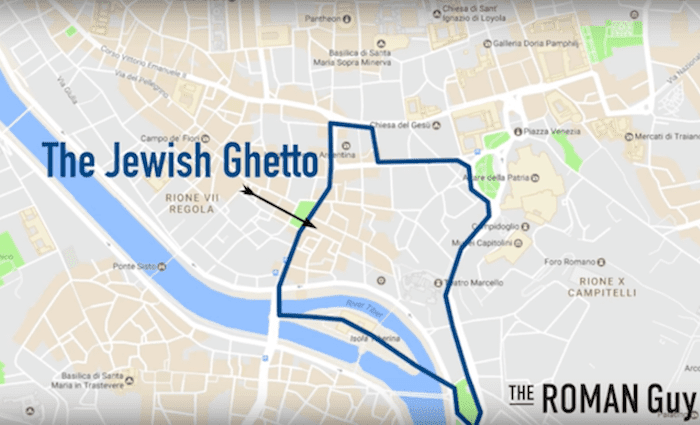
The Rome Jewish Ghetto is in the center of the map, highlighted in blue. It’s on the other side of the street from Campo de’ Fiori. You can walk between the two neighborhoods in about 5 minutes. Southeast of the neighborhood, you’ll see the Colosseo e Foro Romano (Colosseum and Roman Forum), which is only a 15-20 minute walk away.
Looking northwest, you can see St. Peter’s Square and the Vatican, also about a 15-20 minute walk away or four stops on the number 23 bus to Clodio if you’re going towards the Vatican. We urge everyone to walk in Rome, so you can really appreciate the beauty of the city and give yourself the opportunity to stumble across gems you likely wouldn’t encounter on a taxi route.
If you’re not a fan of getting around on foot, however, see our video on how to use the Rome bus system to help you learn how to get around using local transport.
Popular Rome Tours
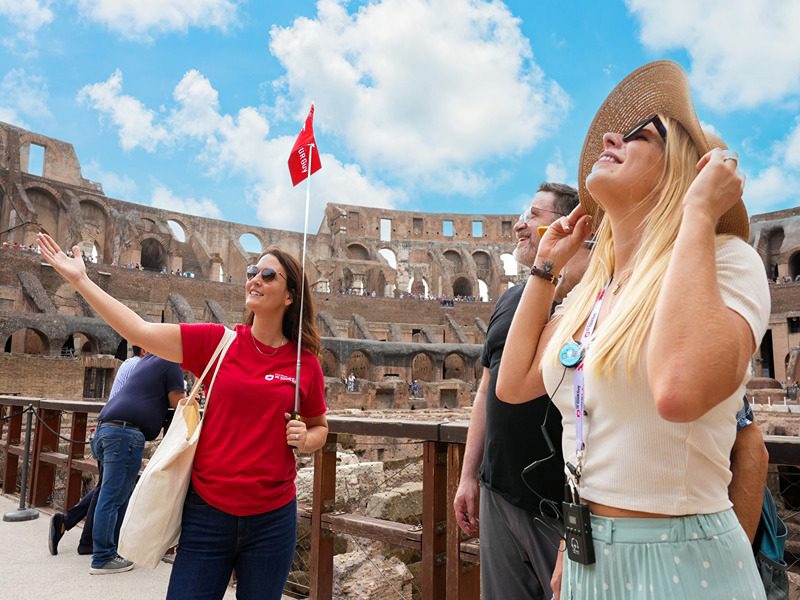
Best-Selling Tour
Rome in a Day Tour with Colosseum and Vatican Museums
Seeing the best of Rome in a single day might seem like a big undertaking, but our expertly designed tour makes it effortless with skip-the-line tickets, included transportation, and engaging guides to lead the way. In just 7 hours, you’ll visit renowned sites like the Sistine Chapel, Colosseum, Trevi Fountain, and Pantheon. With fascinating stories at every stop, you can skip the stress and immerse yourself in the vibrant heritage and culture of Rome all in one remarkable day.
See Prices
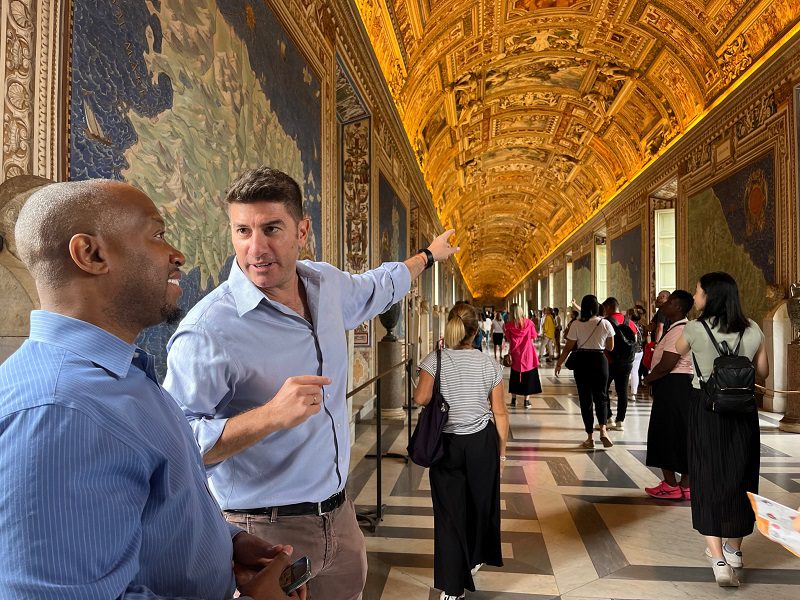
Best Price!
Privileged Entrance Vatican Tour with Sistine Chapel
Without the right access, visiting the Vatican means fighting crowds, long waits, and missing the most significant rooms and works of art. Our privileged entrance tour offers more than just entry—it’s an immersive experience led by a storytelling guide who brings the Vatican to life. Skip the line and explore the Vatican Museums, including the Raphael Rooms and the Sistine Chapel, with engaging insights that make each moment memorable and meaningful.
See Prices
Not ready to book a tour? Check out our Rome Guide for more info.
What To See in Rome’s Jewish Ghetto
The Jewish Ghetto is not a boring area or a dangerous one, so hit the streets and explore. There are lots of different things to do and see, from an ancient market and theatre to an island, an impressive synagogue, a postcard-perfect fountain, and many more attractions. You won’t go hungry here either. There are a lot of restaurants with delicious food and gelato.
In this Rome Jewish Ghetto neighborhood guide, we’ve compiled a bucket list of things to do and places to see for you to tick off when you visit.
1. Isola Tiberina (Tiber Island)
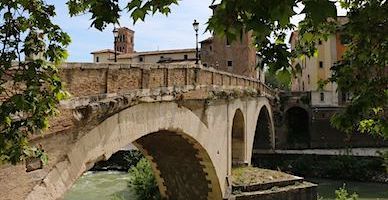
Sitting pretty in the middle of the Tiber river with bridges connecting Trastevere to the Jewish Ghetto is Tiber Island. But this isn’t any ordinary island.
Many Romans believe that you are not a true Roman unless you were born on Tiber island. One of the city’s main hospitals, Fatebenefratelli hospital, is located on the island and has been curing the sick and delivering little Roman babies for over 500 years.
Ponte Fabricio, a bridge connecting the island to the Jewish Ghetto, is the oldest standing bridge in Rome, dating back to 62 B.C.—that’s over 2,000 years old! You can still read the original inscriptions on the side of the ancient bridge. Head over and take some great photos.
Address: Tiber Island | Ponte Fabricio
2. Via del Portico d’Ottavia
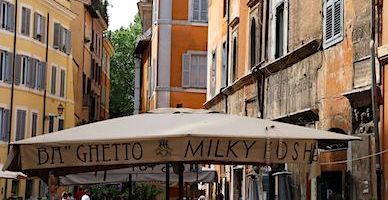
Named after the ancient structure sitting at the end of the road, Portico d’Ottavia, Via del Portico d’Ottavia is considered the main drag in the Jewish Ghetto. There are many things to see on and just off this street.
The Portico d’Ottavia structure was built by Augustus for his sister sometime around 27 B.C. Once home to a library and school, the Portico became the site of one of Rome’s biggest fish markets in medieval times.
Later, a church was attached to the Portico where Jewish Romans were forced to go on Saturdays to listen to sermons with the purpose of converting their religious beliefs. Now, you can wander down to the ancient street level of the structure, go through the back alley, and visit the attached church.
Address: Via del Portico d’Ottavia | Portico d’Ottavia
3. Teatro Marcello (Marcello Theatre)

Many people mistake this structure for the Colosseum when they first visit Rome. It does look similar, but this theatre was actually built before the Colosseum.
It once held up to 20,000 spectators for the theatre and dramatics shows put on here for entertainment. Today, however, you can only visit the outside of this cool ancient theatre.
The structure is currently owned by an Italian noble family. One of the oldest bloodlines in Rome, the Orsini family actually has rights to and lives inside a property older than the Colosseum.
Address: Via del Teatro di Marcello
4. Fontana delle Tartarughe (Turtle Fountain)
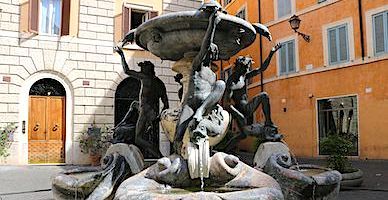
The Turtle Fountain sits just one street back from the main drag, in a little square called Piazza Mattei.
It was built in the 16th century by Giacomo della Porta and sculptor Taddeo Landini. Rumour has it that the turtles around the edge of the fountain were the work of Bernini.
In general, this piazza is a great place to people-watch and grab a frozen yoghurt from Yogurteria.
Address: Piazza Mattei
5. La Sinagoga (Synagogue)
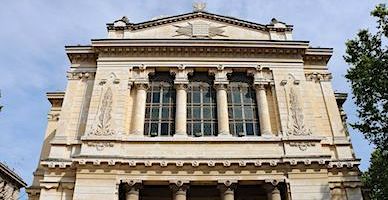
The star of the Jewish Ghetto in Rome is, of course, the Great Synagogue. Built just after the unification of Italy, it differentiates itself from the rest of the dome-topped buildings in the city with its square (not circular) dome.
This means you can easily spot it from most panoramic viewpoints in the city. It’s definitely worth a visit and be sure to ask inside for a local guide to show you around.
Address: Lungotevere de Cenci
6. Largo di Torre Argentina
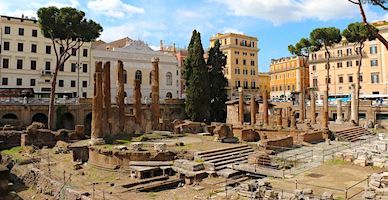
This may not technically be in the vicinity of the Rome Jewish Ghetto, but it’s right next door.
Now a famous cat sanctuary in Rome, these ruins saw the death of Julius Caesar. Many think he was murdered in the Senate House, but the Ides of March took place among these temples.
Today, locals and visitors alike play “spot the cat.” Hundreds of feline friends inhabit this top real estate in Rome’s historical center.
You can’t walk around the ruins, but once a year, the cats’ home is invaded by local Romans to reenact the Ides of March. This is definitely worth seeing if you’re in town on March 15th.
Address: Largo di Torre Argentina
Popular Tours from Rome
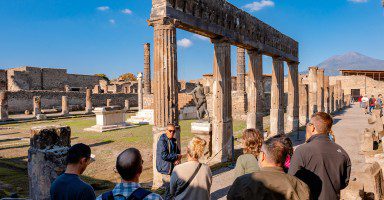
Best Seller
Unforgettable Rome Day Trip to Pompeii and Sorrento
Making a day trip from Rome to Pompeii and the Amalfi Coast can be daunting, with long travel times, complex routes, and tricky logistics to manage. Our full-day tour eliminates the stress, offering comfortbale transport straight to Pompeii. With an archaeologist guide, explore the ancient ruins without the hassle. Then, unwind with free time in Sorrento’s coastal charm. Led by a local guide and small group, this trip makes experiencing Italy’s highlights easy and enjoyable—all in one day.
See prices and more info
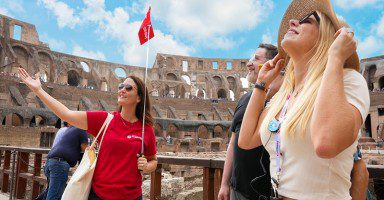
Best Seller
Rome in a Day Tour with Colosseum & Vatican Museums
Seeing the best of Rome in a single day might seem like a big undertaking, but our expertly designed tour makes it effortless with skip-the-line tickets, included transportation, and engaging guides to lead the way. In just 7 hours, you’ll visit renowned sites like the Sistine Chapel, Colosseum, Trevi Fountain, and Pantheon. With fascinating stories at every stop, you can skip the stress and immerse yourself in the vibrant heritage and culture of Rome all in one remarkable day.
See prices and more info
Not ready to book a tour? Check out our Rome Guide for more info.
Where To Eat and Drink in the Jewish Ghetto
Some of our favorite places to eat are in this area. For a more comprehensive list, make sure you check out our top places to eat in the Jewish Ghetto. Here is a selection of spots where you can sit down for a nice meal or have a drink.
Nonna Betta
€€ | Italian Kosher | Outdoor Seating
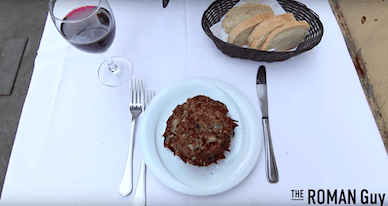
If you ask a Roman to finish this sentence with a famous food, “Jewish style…?” 100% of the time you’ll hear “artichokes!” Why? Because Rome is famous for its two types of artichoke.
The first is the Jewish-style artichoke or carciofi alla giudia, which is a twice-fried artichoke. The other is the Roman-style artichoke or carciofi all Romana, which is steamed then served in oil and herbs. Our preference? Oh, don’t ask us that! They’re both so good! But since you’re in the Jewish Ghetto, you may as well try the Jewish-style artichoke.
We recommend you try the Jewish-style artichoke in the right season to ensure they’re romaneschi artichokes, fresh from February to May. And the best place to get this dish? Go to Nonna Betta.
Now run by Nonna Betta’s grandson, this family establishment claims they are the only real Roman Jews to have kept Roman-Jewish cooking alive and on people’s plates for centuries.
Address: Via del Portico d’Ottavia, 16
Da Beppe
€€ | For Wine and Cheese Lovers | Picnic Foods
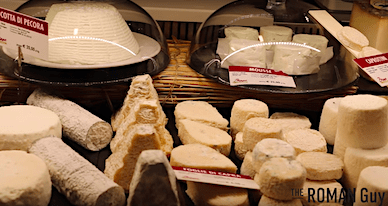
On the same street as Nonna Betta but a little further away from the ancient ruins is Da Beppe. This place is a cheese and wine lover’s dream. They also serve hot dishes and you can even buy picnic supplies to take away with you. Yummy!
Address: Via di S. Maria del Pianto, 9A/11
Boccione
€€ | Kosher | Bakery | Famous for Pizze
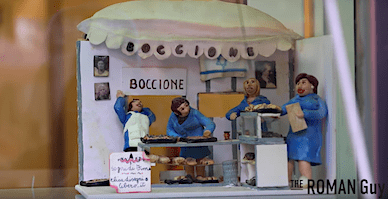
Also on Via del Portico d’Ottavia, this little bakery is run by ladies who make the famous local Jewish dessert pizze. It sounds similar to pizza, but it’s nothing like it. This is a dried fruit pastry dessert that you’ll see people lining up outside for during the day. Once you catch a whiff, you’ll be in that queue in a heartbeat.
Address: Via del Portico d’Ottavia, 1
Pane Vino e San Daniele
€€ | Laid Back | Friendly Service
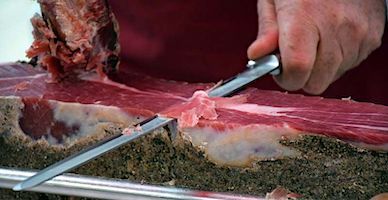
Many complain about the standard of service in restaurants in Italy. It seems you pay for the food, wine, and not much else. But this place is an exception. The food is fab, with great dishes like risotto on the menu. The wine is tasty—we suggest trying something from northern Italy. And the service is very friendly. What more could you want from a place to sit down and enjoy a delicious lunch?
Address: Piazza Mattei, 16
Bartaruga
€€€ | Great Atmosphere | Live Music
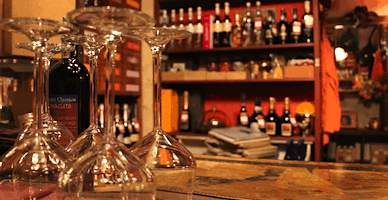
If you’re in the Jewish Ghetto area in the evening, this is the place to go for a craft cocktail or glass of wine. The owner is super welcoming, and if you check their Facebook page, you can plan a visit on a night with live music! They have a great atmosphere with interesting decor and a good selection of wine.
Address: Via dei Funari, 26
Corona Gelateria
€€ | Fresh Ingredients | Interesting Seasonal Flavors
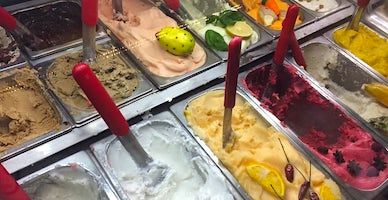
Looking for a great place to get some gelato? This is one of our favorite gelaterias in all of Rome! The family who runs this little shop near Largo di Torre Argentina use nothing but fresh seasonal ingredients to make their gelato.
The pistachio is a brown-green color, meaning it doesn’t have any additives. They also serve weird and wonderful flavors like lemon and basil and sometimes even tobacco. Expect richer flavors in winter and zestier flavors in summer. We promise you won’t regret the visit.
Address: Largo Arenula, 27
Here’s Where To Stay in Italy’s Most Popular Destinations
Rome, Florence, Venice, Amalfi Coast, and Capri

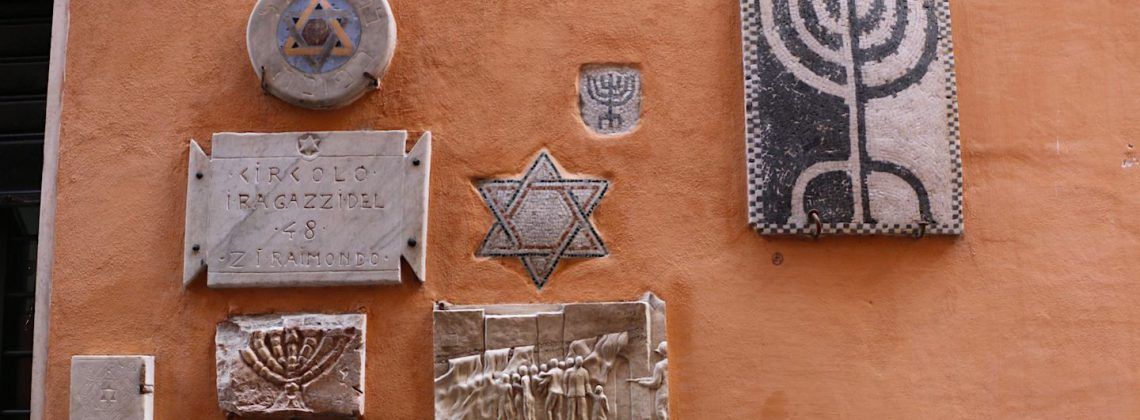
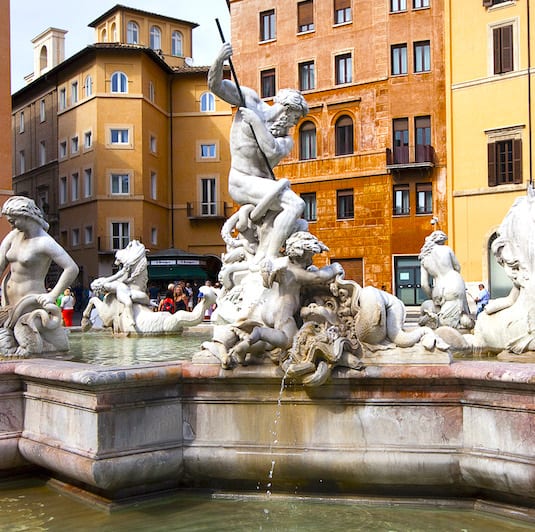
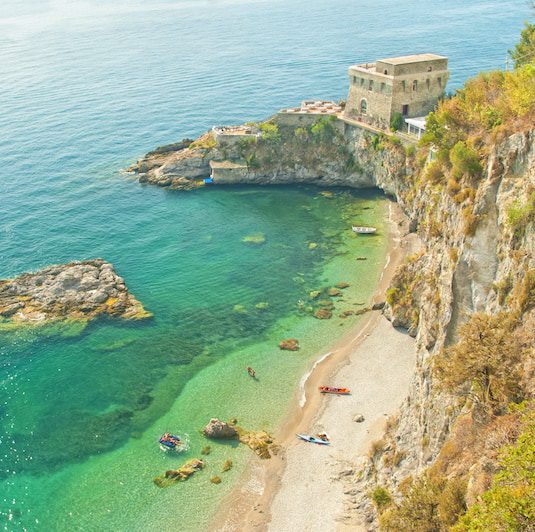
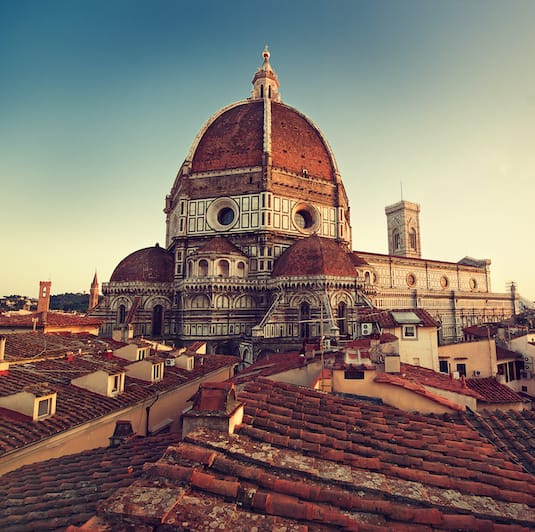
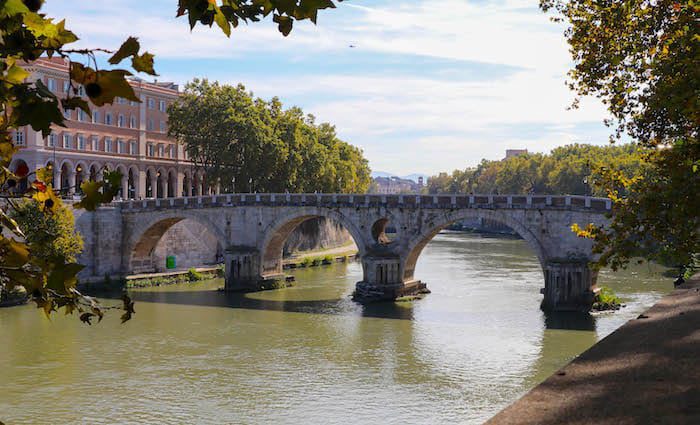
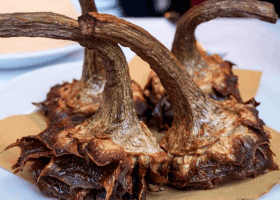
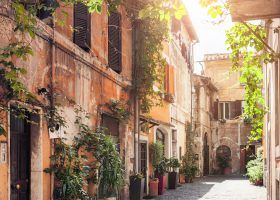
Thanks for sharing. Rome is much more than just the Colosseum and Vatican museums. I didn’t know about the Hidden gems in the Roman Jewish ghetto
Had a great following your itinerary. One of best days in Rome, and they have all been wonderful. Thanks so much for sharing.
Hey Vicki! We’re so glad to hear that you enjoyed reading our blog. It’s great to hear when clients enjoy our travel tips! Keep checking out our new posts 🙂
Thank you so much! We had a wonderful time. Interesting and yummy. My two teen boys enjoyed learning more about their heritage (we live in the USA).